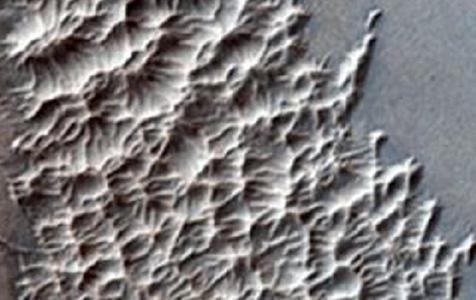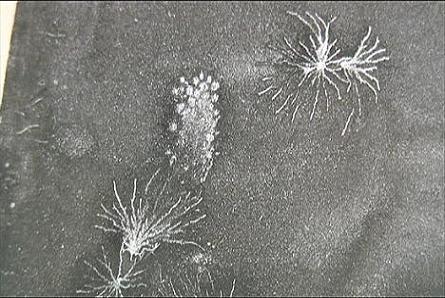by electric discharge
between two CRT screens.

The following features were made during an experiment involving two CRT monitors passing in close proximity screen to screen

One monitor was powered on and the other off.
One of the screens was completey clean.

Powdered material was applied to one monitor and was transfered to this other one during interactions

Star-like patterns
Created in Backyard Experiments
In a backyard experiment
tstar-fish looking features have been duplicated in great detail. We now
have a repeatable experiment producing these patterns from
electrical discharges so now a question can be justifiably
raised; what electrical process could be responsible for
similar features on Mars at its equaiorial region? That won't be answered here but give an explanation of sorts about the experiment.
What follows is the details
of the experiment and the patterns which resulted.
To help you understand the
electrical dynamics behind these figures we can look at
Lichtenberg figures and then scale them down to compare
these patterns caused in a transfer of powdered material
to this old VGA CRT from another where it was placed.
You will want to refer to a site called Thunderbolts.info were
they are featuring articles on this subject and numerous
others in the TPODs.
This experiment involves an
Old VGA CRT that may have some internal malfunction which
might be contributing to a tendency for these discharges of low
intensity across the face of the exposed surface of the
tube. For this experiment houshold powders (foot powder and baking soda)
were distributed in various depths, less than a 1/32th in most areas on one monitor, the other was totally clean.
Patterns of many types have been demonstrated but
these spiders are something to behold, a real-time example
in scaled-down form of amazing similarity to star-like dunes on Mars.
To make these
patterns, which were consistently made as the positive-relief
deposition, it will be a bit challenging. Start
with a clean monitor and a second monitor with material
coating the screen. With one monitor suspended facing down and on a trolly rail and the other, with material, faced up and stationary, pass the one monitor over the other at close proximity screen to screen. Try different power settings, for example bottom cycled off and top one cycled to on. Something should happen if the monitors have surfaces which are electrostatically active.
More info will be added as
more clarity comes.
You can compare these images with adjacent
images of features commonly seen on Mars.
We are aware of the plasma nature of the space
environment and the plasma sheaths that form around bodies
in space
as they move within the solar stream of charged particles.
Reason exists to conclude that these bodies become charged
with their own state of charge (potential). We know that two
objects of differing charge potential will discharge in arc
mode as
they come into close proximity but even before that happens
there are other modes of discharge which can reveal their
activity in loosly bound material on the surface of an
object such as a CRT.
In the description attempted here the modes of discharge will
not be delt with in specifics but be mentioned in association
with whether a physical arc was seen or heard. This will be arc mode
If acticity
occurs without an arc this will be regarded as a dark discharge
since nothing visible or audible has occurred. The glow mode of
plasma discharge does not seem applicable at this point in the experiments.
The CRT experiments give us a unique opportunity to see the
reaction of different materials to electric discharge of two
types.
During an electric discharge,
material might be removed from the surface and redistributed in
specific manners or distributed to the surface from another object
in close proximity.
Compare the images at the
links to the left with images from space missions and
see for yourself. Decide for yourself, from this
evidence and that obtained from your own experiments, what
is the most believable explanation for the formation of
surface features in this electrically active universe.
More details will be added so check back
again.